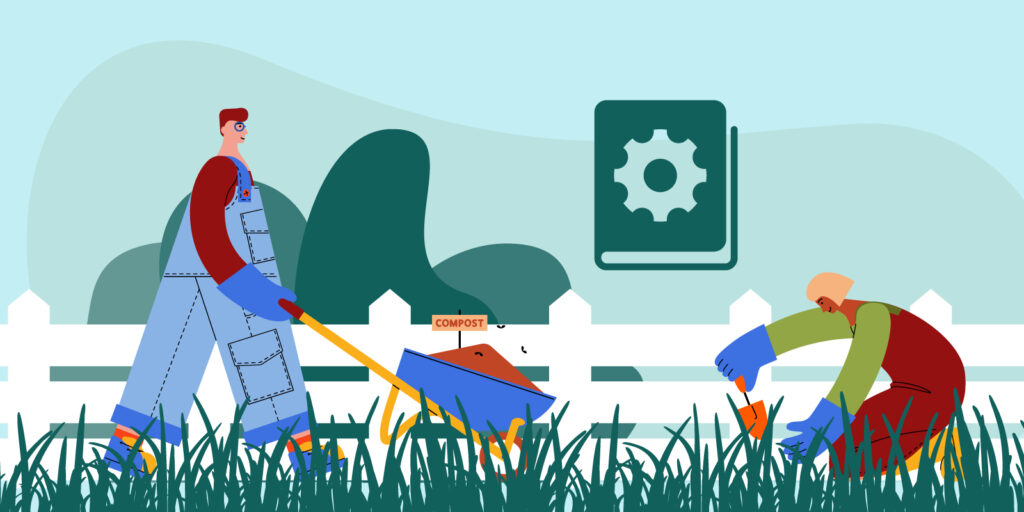Every homeowner wants a lush, green lawn. Unfortunately, things like high heat, humidity, and drought can interfere with those plans by making your lawn dull and brown. If you’re unhappy with your lawn and want to restore it to its former green glory, fertilization can help. Keep reading to discover our top tips, from the best type of fertilizer to when to apply fertilizer and why fertilizing your lawn matters.
When is Grass Growing Season?
Before we get into what your grass needs to grow, let’s get into the actual timeline for grass growing season.
In the United States, grass growing season usually begins in late March or early April and continues through late October, unlike other flowers or plants that begin in early spring. During this time, grass requires cool temperatures and plenty of water to thrive. The hottest months of the summer can cause your lawn to brown out and go dormant, but with regular care, such as mowing and fertilization, it will remain healthy throughout the growing season.
Warm Season Grasses
Warm season grasses are types of grass that prefer warmer climates and can tolerate periods of drought. Common warm-season grasses include Bermuda, St. Augustine, Zoysia, Centipede, and Bahia. These grasses typically require more frequent mowing than cool-season grasses as they grow faster in the summer months. Warm-season grasses are also less tolerant of cold weather and may not survive in regions with severe winter temperatures.
Cool Season Grasses
Cool season grasses are the types of grass that grow best in cooler temperatures and survive the harsh winter months. Common cool-season grasses include Kentucky bluegrass, perennial ryegrass, tall fescue, fine fescue, and turf-type tall fescue. These grasses are hardier than warm-season grasses and can often thrive in climates with more precipitation. They also require less frequent mowing as they typically grow slower than warm-season grasses.
Other types of grass include annuals such as ryegrass and crabgrass; ornamental grasses such as fountain grass and pampas grass; and native or wild varieties such as bluegrasses, bermudagrass and Indian ricegrass.
What Does Grass Need to Grow?

Before we examine how fertilizer works, it’s important to understand the basic elements of grass care. In order for your lawn to flourish, it needs the following nutrients:
- Nitrogen: Promotes grass growth
- Phosphorus: Encourages root and seed development
- Potassium: Helps prevent disease and drought
These substances are naturally found in soil, where grass absorbs them through its roots. However, for some lawns, there may not be enough nutrients to promote healthy growth. For example, improper lawn care from a previous homeowner or excessive drought can cause soil to lose its nutrients, leading to weak, unhealthy grass. Fertilizers can solve this problem.
What’s In Fertilizer?
Put simply, fertilizer is a natural or artificial substance that boosts plant nutrition. A typical bag of fertilizer displays three numbers, which are each connected to one of the main plant nutrients. For example, a fertilizer bag that reads “20-10-10” has 20% nitrogen, 10% phosphorus and 10% potassium. The ideal ratio depends on your needs — for plant growth, you generally want a 2-1-1 or 3-1-1 ratio.
There are four common types of grass fertilizers: Nitrogen Fertilizers, Phosphorus Fertilizers, Potassium Fertilizers, and Organic Fertilizers.
Nitrogen fertilizers are typically used to promote growth in warm-season grasses like Bermuda and Zoysia. Phosphorus fertilizers are used to help roots establish and grow, while potassium fertilizers help strengthen the plant’s overall immunity. Organic fertilizers provide essential nutrients while also improving soil health by increasing water retention and reducing weed growth.
Quick Release vs. Controlled Release Fertilizers
In addition to considering the nutrient ratio, it’s important to determine what type of fertilizer you want. It’s available in two main varieties:
Controlled-release, also known as slow-release fertilizers, are made of granular beads. These release nutrients into the soil over a long period of time, usually around six to eight weeks. Quick-release versions, on the other hand, consist of liquid or water-soluble beads. As the name suggests, they release their nutrients immediately. While quick-release fertilizer delivers faster results, the soil also loses its nutrients sooner. This means it will require more applications in the long term.
When You Can, Choose Organic
Not only does fertilizer offer different speeds, but it’s also available in both natural (organic) and synthetic (inorganic) forms. Organic fertilizer is made up of materials that come from plants or animals, such as manure or compost. Once it’s released into the soil, it’s broken down by microorganisms before being drawn in through plant roots. Inorganic fertilizer, meanwhile, releases chemical nutrients that are absorbed quickly. However, because so many nutrients are readily accessible, the grass may not be able to absorb them all.
While both slow-acting organic fertilizer and quick-acting inorganic fertilizer are effective in encouraging plant growth, organic fertilizer is often recommended due to its long-lasting effects. Over time, organic fertilizer can improve soil structure, creating a healthier environment for your lawn.
When Should You Fertilize Your Lawn?
Once you’ve chosen your fertilizer, the next step is determining when to fertilize your lawn. The answer varies depending on location and the type of grass. In general, you should fertilize grass in early September. Grass begins developing roots during early fall, which means it’s a good time to absorb essential nutrients. Not to mention, temperate weather is ideal for fertilization. When it’s too hot, soil dries out; when it’s too cold, soil freezes. Either way, poor soil conditions will prevent fertilizer from doing its job.
Depending on your lawn, you might find that one fertilization a year is all you need. If your lawn starts dying as winter progresses, you may want to apply some more and set up a lawn fertilizer schedule for yourself. If you decide to add another round, plan on doing so in the late spring when the weather is moderate again.
When Not To Fertilize
For the best results, avoid applying fertilizer when the grass is wet, such as in the morning, after a rainstorm or after you water it. The morning dew may make grass sticky, preventing fertilizer from reaching the soil. Also, avoid applying fertilizer during the hottest part of the day. Instead, choose a time in the late afternoon or early evening when the dew is gone and there’s no direct sunlight on the lawn.
How Do You Fertilize a Lawn?
Now that you know what fertilizer is and when to apply it, it’s time to actually fertilize your lawn. If you’re new to lawn fertilization and fertilization application, the process may seem daunting. That’s why we’ve assembled a quick, step-by-step guide to walk you through the process.
Step One: Water Your Lawn Early
About two days before you plan to fertilize, water your lawn thoroughly. Adding moisture to the soil, then letting it dry will help prepare it for fertilization.
Step Two: Buy a Spreader
Before you can apply fertilizer, you’ll need a spreader. This is a device that helps distribute the fertilizer throughout the lawn. There are two types to choose from:
A broadcast spreader releases fertilizer in a fan-like pattern across your lawn. While it works quickly, you can’t always control where the fertilizer goes — for instance, it can end up on your driveway or sidewalk. In contrast, drop spreaders apply fertilizer exactly where you want it. However, they’re rather time-consuming to use, and they cover less ground than broadcast spreaders. In general, broadcast spreaders are more suitable for larger lawns, while drop spreaders work well with small lawns.
Step Three: Apply the Fertilizer
Once you’ve watered your lawn and assembled all the materials, you can start applying the fertilizer. You’ll want about two pounds of nitrogen for every 1,000 square feet. So, for instance, if your fertilizer has 20% nitrogen, you’ll need 10 pounds for every 1,000 square feet.
When spreading the fertilizer, start with the perimeter of your yard. After the edges are complete, walk back and forth through the middle in straight rows. A good rule of thumb is to pretend you’re mowing your lawn. When you’re done, return any extra fertilizer to the bag and store it in a cool, dry location where pets or children can’t access it, such as a garage.
Step Four: Water Your Lawn Again
The final step is to water your lawn again. This second dose of water will activate the fertilizer and encourage nutrients to spread through the soil. Ideally, you should wait about 12 to 24 hours before watering, as this will give the fertilizer some time to settle. Once you’ve completed all these steps, the only thing left to do is sit back and enjoy your gorgeous green grass!
Fertilizing Your Lawn Wrap Up
Fertilizing your grass is an important part of maintaining a healthy lawn. It helps to promote strong root growth, increases tolerance to drought and disease, and encourages lush green foliage. Different types of grasses respond best to different fertilizers, so it’s important to identify the type of grass in your lawn before selecting the appropriate fertilizer for your particular needs. With proper care, regular fertilization and listening to your specific lawn needs, you can have a beautiful lawn that will last for years to come.
You might also be interested in: The 7 Best Ways To Get Rid Of Weeds In Your Yard And Stop Them Coming Back




